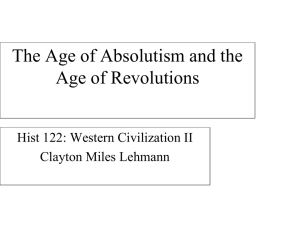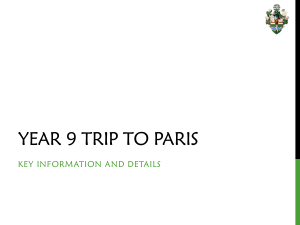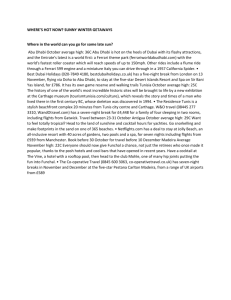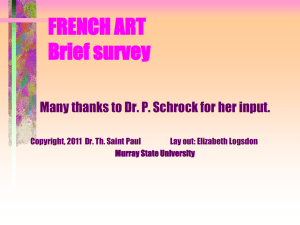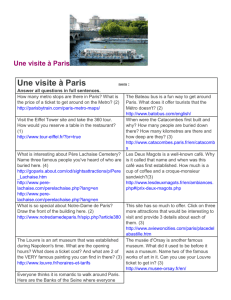The Louvre Abu Dhabi aspires to be a universal museum that
advertisement
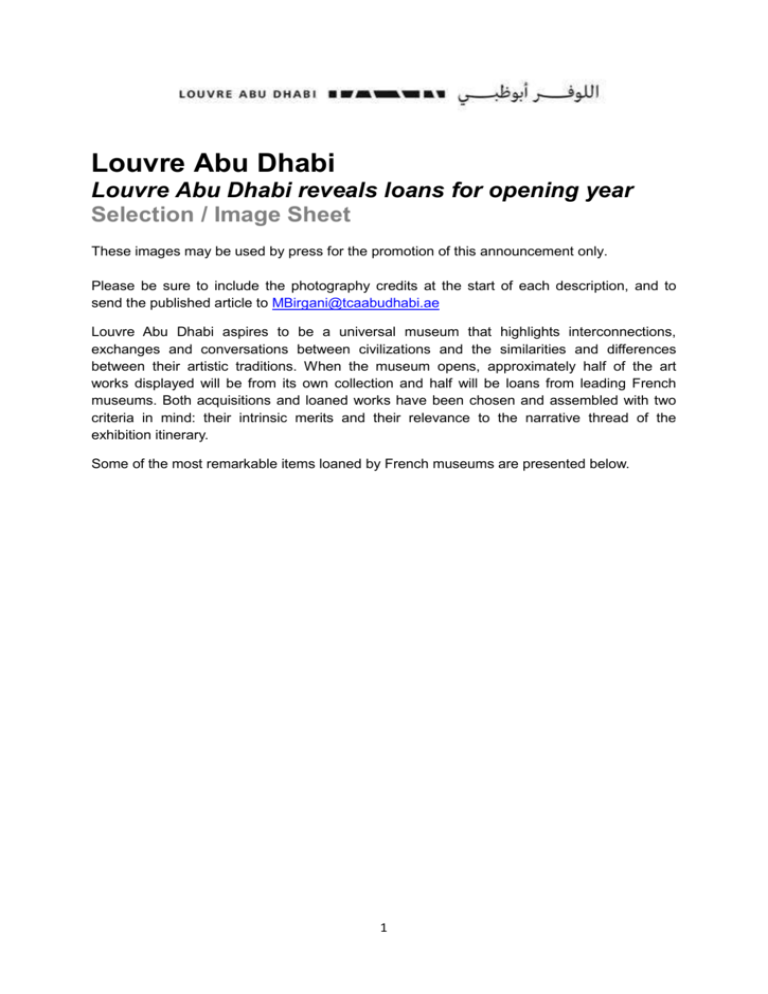
Louvre Abu Dhabi Louvre Abu Dhabi reveals loans for opening year Selection / Image Sheet These images may be used by press for the promotion of this announcement only. Please be sure to include the photography credits at the start of each description, and to send the published article to MBirgani@tcaabudhabi.ae Louvre Abu Dhabi aspires to be a universal museum that highlights interconnections, exchanges and conversations between civilizations and the similarities and differences between their artistic traditions. When the museum opens, approximately half of the art works displayed will be from its own collection and half will be loans from leading French museums. Both acquisitions and loaned works have been chosen and assembled with two criteria in mind: their intrinsic merits and their relevance to the narrative thread of the exhibition itinerary. Some of the most remarkable items loaned by French museums are presented below. 1 1 - Statue of Gudea, prince of Lagash, praying Circa 2120 B.C.E (Neo-sumerian period, Gudea reign, 2125 2110 B.C.E) Tello, ancient Girsu (Iraq) Diorite 107 cm x 36,5 cm x 25 cm Musée du Louvre, Near Eastern Antiquities Departement, © 2007 Musée du Louvre - High Museum / Peter Harholdt The Birth of Civilisations section will offer the viewing of contrasted representations from emblematic figures who reigned over the earliest kingdoms and empires. Gudea, who ruled over the Mesopotamian kingdom of Lagash, was famously pious and built many temples. He is shown standing, enveloped in a fringed mantle and wearing the traditional royal turban, with his hands clasped to indicate his devoutness. The quality of the sculpture is indicative of the high level reached by Mesopotamian art tradition at the end of the third millennium BCE, when the representation the human figure in sculpture was already long-established. 2 - King Ramesses II Diorite 1279 - 1213 B.C.E. (19th dynasty) Found at Tanis H. : 2,59 m. ; L. : 0,80 m. ; W. : 1,20 m. Musée du Louvre, Egyptian Antiquities Department © Musée du Louvre, dist. RMN / Christian Décamps No museum dealing with the great civilizations of antiquity would be complete without a monumental effigy of a pharaoh. This statue will be one of the high points in the tour of Louvre Abu Dhabi. It will complement the museum's acquisitions in Ancient Egyptian art, which at the moment have mainly focused on the topic of funeral rites. The monumental statue of Ramesses II will be set in counterpoint to a figure of the Mesopotamian prince Gudea, the two of them offering contrasting images of the splendor of the royal person. Ramesses II is shown in the conventional posture of the pharaohs, seated on a cubical throne, with his hands placed flat on his thighs, wearing the nemes headcloth with a rearing cobra on the brow. 2 3 - Pair of gui vessels China 11th century BCE Bronze 25 cm Musée national des arts asiatiques-Guimet, Paris (National Museum for Asian Arts) © Musée Guimet, Paris, Dist. RMN-Grand Palais / Jean-Michel Routhier These two deep vessels resting on square bases were discovered in China in 1929. At the end of the Western Zhou dynasty, gui vessels were usually cast as single pieces with wide parallelepipedic pedestals. They are flanked by two handles in the shape of a dragon swallowing a bird with only the base of the wings still visible. From recognisable animal decorations inherited from the art of Shang period and still common at the beginning of the Zhou dynasty, the 9th century saw the emergence of a new vocabulary of geometric patterns. Nearly flat hooks only offer a faint echo of the original animal shape. Inside each receptacle, 111 characters are inscribed and explain the history of the cast. Thus we know that the Ling family had the set produced using a royal gift around one thousand years BCE. Vases would become historical monuments made on the occasion of major events, which history is recorded on such thin bronze walls. 4 - Breastplate of Marmesse Marmesse, Haute Marne, France 9th-8th century BCE Bronze 51.2 cm Musée d’Archéologie nationale – Saint-Germain-en-Laye, (National museum for French Archaeology) © Valorie Gô - Musée d'Archéologie nationale This breastplate was one of seven similar pieces that were found by chance. They had been stored together intentionally, no doubt for ritual purposes. These seven breastplates are decorated in a similar yet exceptionally sumptuous manner that has no real equivalent up to now in Europe. Small lines of studs run in areas marked off by small pearls, in parallel lines and curves. The rich decorations adorning this defensive armour indicates that it was ceremonial rather than for use in war. This find - the only one of its kind - is a superb testimonial of the talented metalworkers and armourers of the Bronze Age. 3 5 - Mattei Athena Roman Empire, 1st-century BC/AD Roman copy of a 4th-century BC Greek original 230 cm Marble Musée du Louvre, Greek, Etruscan and Roman Antiquities Department © RMN (Musée du Louvre) / Hervé Lewandowski Several examples of monumental sculpture will be joining Louvre Abu Dhabi's substantial collection of Greek art. The larger than life-sized statue known as the Mattei Athena will provide a majestic illustration of the Classical period in statuary and complete the series of acquisitions of the Louvre Abu Dhabi begun in 2011 with an archaic female Sphinx. This figure of Athena is sometimes called the Pacific Athena on account of the goddess' gentle expression. The position of her hands and the fact that her aegis is simply worn as a sash are the only reminder that she is the goddess of Wisdom as well as of War. 6 - Mask Mexico, Basin of Mexico 150-550 CE Black stone 20 x 18 x 12 cm Musée du quai Branly, Paris © musée du quai Branly, photo Hughes Dubois This anthropomorphic mask sculpted from black stone is representative of the Teotihuacan culture in Mexico. The mask was originally encrusted with shells and fragments of obsidian to represent the pupils and teeth, making it both expressive and realistic. This piece embodies a great Mesoamerican civilization that grew up at around the same time as Han China and the Roman Empire. It was formerly part of the collection of the writer André Breton. 4 3 - Blue lady China 8th century AD Glazed terracotta 38.5 x 6.5 cm Musée national des arts asiatiques-Guimet, (National Museum for Asian Arts) © RMN-Grand Palais (musée Guimet, Paris) / Thierry Ollivier This cobalt-glazed figure of a court lady exemplifies a style in vogue in China during the Tang dynasty (618-907) at its zenith. The court lady ample figure is draped in a long tunic whose dark-blue color was made using cobalt-blue color imported from Iran. Her wide face, full cheeks and prettily arched laurel-leaf eyebrows counterbalance her voluminous hairstyle. As a testimony of this period characterized by the international expansion of imperial China, this rare work fits perfectly with the museum's curatorial program and completes ideally the group of Tang masterpieces acquired by Louvre Abu Dhabi. 8 - Fountain spout known as the Monzon Lion Spain, 12th-13th century Cast bronze with engraved decoration 31.5 x 54.5 cm Musée du Louvre, Islamic Art Department © 2012 Musée du Louvre / Philippe Ruault This is one of the masterpieces of the Islamic Art Department of the Musée du Louvre. Used as a fountain spout, it was found at Monzón in the Spanish province of Palencia. It is one of the few metal items of this kind preserved dating back to the Islamic kingdoms of Western Europe. The very fine floral Kufic inscription engraved in the bronze dates it from the 12th or 13th century. It wishes the owner "Baraka kamila/Ni’ma shamila" (Perfect blessing, Complete happiness). This object displays striking similarities with lion-shaped aquamaniles in 13th-century German goldwork and brassware, which many consider to have been directly influenced by the zoomorphic vessels produced in the Andalusian workshops. 5 9 - Reliquary chest Egypt and Northern France (?) 13th century Silver, rock crystal, pearls 11.3 x 14.8 x 9.7 cm Musée de Cluny - musée national du Moyen Âge (National Museum for Middle Age) © RMN-Grand Palais (musée de Cluny musée national du Moyen-Âge) / Franck Raux In the wing devoted to the medieval period, Louvre Abu Dhabi reflects on how contacts between civilizations has enriched their artistic traditions. This stunning reliquary from the cathedral of Moûtier-en-Tarentaise, one of the treasures of the French National Museum for Middle Ages, will highlight exchanges between cultures around the Mediterranean rim. It was made by reusing plates of rock crystal from a secular casket made in Fatimid Egypt in the 10th century, and then adding a silver-gilt mount typical of northern French goldwork between 1200 and 1210. This piece shows how the circulation and reuse of Islamic objects encouraged the spread of Oriental motifs through Europe at the same time as placing them in a totally Christian context of Western Europe. 10 - Salt cellar Nigeria, Benin Empire beginning of 16th century Elephant ivory 26 x 8 x 8.5 cm musée du quai Branly © musée du quai Branly, photo Thierry Ollivier, Michel Urtado This rare salt cellar comes from the Benin Empire, located to the southwest of today's Nigeria and dates back to the 16th century. At the time, many royal workshops worked with elephant ivory. Some objects were produced for the local elite while others, like this one, were manufactured for export and brought back by the Portuguese for a rich European clientele. The lower part of this salt cellar depicts four bearded Portuguese soldiers. Two of them holding a lance and a sword are wearing European garments, a hat with a feather, and a cross pendant on their chest. The other two figures are wearing a helmet and carrying a small shield. On the top, the image of a caravel with a sailor is an illustration of the picturesque and African look on new realities. 6 11 - Woman Portrait, also called La Belle Ferronnière Leonardo da Vinci Milan, Italy, 1495-1499 Wood (noyer) Musée du Louvre, Paintings Departement © Musée du Louvre, dist. RMN / Angèle Dequier Leonardo da Vinci is probably one of the most famous and popular artists in the history of art. Louvre Abu Dhabi will have the opportunity to display one of his most attractive works - a portrait of an elegantly dressed young woman painted when the artist was based in Milan. Thematically, this picture will illustrate Renaissance artists' quest for naturalism with the aid of the new technique of oil painting. It will echo Louvre Abu Dhabi's own Bellini’s Madonna and Child, also painted in oil on wood, another head-and-shoulders portrait in which the figure is depicted behind a parapet and against a dark background. 12 - Woman with a Mirror Tiziano Vecellio, known as Titian Venice, Italy, c. 1515 99.0 x 76.0 cm oil on canvas Musée du Louvre, Paintings Department © Musée du Louvre, dist. RMN / Martine BeckCoppola The softness and new sensuality with which Titian depicted his human subjects represent a crucial turning-point in the history of European art. Like the Da Vinci portrait, this painting, loaned by Musée du Louvre, will be located in a section focusing on the new naturalism in Renaissance painting. 7 13 - Apollo Belvedere Francesco Primaticcio (1504-1570) France, 1541-1543 Bronze 218 cm Château de Fontainebleau, © Adrien Didierjean, RMN-GP Château de Fontainebleau King Francis the 1st of France was one of the most important patrons of the arts of his day. He sought to gather the leading artists of the Renaissance and the greatest art treasures in his castle in Fontainebleau. He was especially interested in classical art - the main yardstick against which art was measured at the time. He asked the Bolognese painter Francesco Primaticcio, who was then working for him, to travel to Rome to purchase classical sculptures and take mouldings of the most famous pieces, among them the Antiques of the Vatican. It was as a result of this trip that Primaticcio made in the castle of Fontainebleau this bronze replica of the famous marble statue. This prestigious statue will offer a perfect illustration of the theme of the influence of models from the ancient world on the creators of new art. 14 – Dish with blue flowers patterns Italy, Florence c. 1575-1600 Ceramic known as Medicis Porcelain, cobalt painted decor 30 cm Sèvres, Cité de la céramique © RMN-Grand Palais (Sèvres, Cité de la céramique) / Jean Popovitch This Florentine dish is a rare example of artistic emulation coming from exchanges between artistic traditions of different civilizations of the world. This dish in blue and white colors produced in Florence at the end of the sixteenth century is indeed characteristic of the first European attempts to imitate Chinese porcelain. The beauty and solidity of porcelain vases imported from China have prompted European potters to innovate in trying to find the secret technique of that white, soft, translucent, vitreous and sound material. The choice of a decoration in white and blue shows China's inspiration for this dish. The secret of porcelain - the use of kaolin clay - will be discovered quite late by Europeans, at the early beginning of eighteenth century. The so-called Medici "porcelain" is actually a "soft paste" without kaolin. 8 15 - Ewer of Persian shape China, 16th century AD 47 cm Porcelain, Gilded Bronze musée des Arts décoratifs © Les Arts Décoratifs, Paris/Jean Tholance This Chinese porcelain ewer is embedded in a Western gilt bronze mount with a lid in European ceramic. Mould in white clay, the piece is made out two parts made separately and joint in a second time. On the belly, symmetrical designs are deeply incised in the raw clay and represent a flaming jewel springing out of a lotus flower and flanked by foliate scrolls. Other symmetrical foliage are arranged on each side around the spout and handle. Protruding rings are separating the shoulder and the mouth. The shape and the vigor of this object are surprising. It is apparently unique and could be a specific command, like the famous ewer made for the King Manuel I of Portugal. The bluish-white cover suggests a production from southern China, perhaps ordered by a Middle Eastern traveler visiting one of the major trading ports of the region. 16 – Apollo with the Nymphs François Girardon (1628-1715) France, 1666-1675 circa 2 x 4 m marble Musée national des Châteaux de Versailles et de Trianon © Château de Versailles. Dist RMN / J.M. Mana The group of seven sculptures in Carrara marble depicting Apollo served by nymphs was directed by François Girardon between 1666 and 1672 – the group represents the god of sun, of beauty and arts preparing for sunset. The nymphs surrounding him lavish a Vespers toilet before going to join the goddess Tethys. Originally, this group was sculpted in the garden of Versailles in a grotto cave called Tethys. At the Louvre Abu Dhabi, the group will illustrate the theme of the image of the prince. Louis XIV took the sun as an emblem, and the 9 iconography of the arts in Versailles around the myth of Apollo was a form of glorification of the king. This sculpture group is, thus, one of the most prestigious illustration of the representation of the prince in European culture of the classical age. For the silhouette of god, Girardon was closely inspired by the most famous representations of Apollo inherited from antiquity: the Apollo of the Belvedere. The Louvre Abu Dhabi also borrows for its first year of opening, a copy of the Apollo of the Belvedere created during the Renaissance by the Primatice for the Château de Fontainebleau. The unprecedented face to face a few feet away of the two works will be very eloquent. 17 - Globe Vincenzo Coronelli (1650-1718) Venice, Italy, 1697 146 x 107 x 107 cm Bibliothèque nationale de France, Maps and Plans Department © Bibliothèque nationale de France, département des Cartes et plans A room dealing with the Age of Discovery is located halfway on the tour of Louvre Abu Dhabi. Several topics have been chosen for this space including the exploration of the globe, the discovery of other cultures and the cabinets of curiosities. The voyages of European navigators from Christopher Columbus to James Cook triggered a first wave of globalization. Coronelli's globe, loaned by the Bibliothèque nationale de France, embodies this notion. Vincenzo Coronelli was a famous cartographer who made globes of the earth and the sky of a very high standard. In parallel, Louvre Abu Dhabi owns also in its collection an Arab astrolabe that represents Arab science's contribution to the circulation of knowledge from the Middle East to Europe. 10 18 - Napoleon Crossing the Alps Jacques-Louis David (1748-1825) France, 1803 Oil on canvas 267.5 x 223 cm Musée national des châteaux de Versailles et de Trianon © RMN (Château de Versailles) F. Raux This portrait of Napoleon Bonaparte on horseback is an iconic image. This remarkable painting that illustrates the genius of the most important painter of the time captures also an important moment in history. Louvre Abu Dhabi's itinerary includes a section about the turning-point of the late 18th century when the American and French Revolutions and the rise of Napoleon sparked a feeling that individuals could change the course of history. Louvre Abu Dhabi has acquired a portrait of George Washington which fits also perfectly in this theme. 19 – The Fife player Edouard Manet (1832-1883) France, 1866 161 x 97 cm Oil on canvas Musée d’Orsay © Musée d'Orsay, dist. RMN-Grand Palais / Patrice Schmidt Manet's work epitomizes the sensibility of modern artists in search of new sources of inspiration. Fascinated by Velasquez' Pablo de Valladolid, which he first saw in the Museo del Prado in 1865, Manet borrowed several features from it in The Fife-player, painted the following year - notably the disappearing background, which especially struck him, and which he compared to air surrounding the figure. Manet chose a subject from everyday life - an anonymous boy soldier whom he turned into a monumental figure like a Spanish grandee, set in an indeterminate space. He also used a simplified language, a limited palette, and colours applied in flat blocks. Alongside The Bohemian, with its quintessentially Spanish subject, The Fife-player illustrates in a different and complementary way the influence of paintings from the Spanish Golden Age on Manet's work. 11 20- Masque anthropo-zoomorphe d’mba Masque d'épaules D'mba, Guinée, Baga, début du 20e siècle, bois, fibres végétales, métal, 130 x 55 x 68 cm Paris, musée du quai Branly © musée du quai Branly, photo Patrick Gries, Bruno Descoings The D’mba headdresses masks are among the best known and the most fascinating ones of the Baga ritual art. D’mba embodies a beneficial and protective spirit for human beings, flora and fauna. The mask is carried out to dance in public for the fertility of grounds, fertility of beings, weddings and in a secret context, for the ceremonies which accompany the dead toward the world of their ancestors. It represents a woman with maternal breasts, a crested hairstyle, scarifications and an aquiline nose which evokes the hornbill’s beak. Its proportions, its simple and elegant forms as well as the care brought to the ornamental sculpted motifs decorating the mask give it the great aesthetic strength that struck the interest of the 20th century artists. The collection of the Louvre Abu Dhabi possesses a photography taken by Walker Evans of a similar mask which was presented in the important exhibition of African Art at the MoMA in 1935. 21 – La gare Saint-Lazare Claude Monet (1840-1926) France, 1877 75.5 x 104 cm Oil on canvas Musée d’Orsay © Musée d'Orsay, dist. RMN-Grand Palais / Patrice Schmidt With this totally new subject, utterly in tune with changes taking place in the society, Monet offers more evidence of the modern sensibility. The subject of the station - a place of constant movement, with trains arriving and departing, and a temple of technology, with its glass and steel architecture, is in itself a symbol of modernity and modern life. Monet depicts the steam from the trains and the passengers against the backdrop of Haussmann's Paris. In places, the subject is subsumed by colour, resulting in an almost abstract vision. The SaintLazare Station provides a superb foil to another scene from modern life, Gustave Caillebotte's The Game of Bezique, from Louvre Abu Dhabi's collection. 12 22 - Bacchus in the Vat Auguste Rodin (1840-1917) France Marble 61.5 x 46.7 x 45 cm Musée Rodin, Paris © musée RODIN (photo Christian Baraja) Rodin carried on a fertile dialogue with Antiquity since his younger years until his death,. He had a vast collection of antiques from which he drew a great deal of inspiration. Bacchus in the Vat is the result of a creative process that began with one of the works in his collection: an antique terracotta kylisc. Rodin brought the central motif of the piece to life in this sculpture. The process took several steps, one of them an assemblage made up of a Bacchus pulling himself out of a sort of vat, in this case a Greek vase. 23 - Self-portrait Vincent Van Gogh (1853-1890) France, 1887 Oil on canvas 44 x 35.5 cm Musée d'Orsay © Musée d'Orsay, dist. RMN-Grand Palais / Patrice Schmidt This self-portrait was painted in autumn 1887, during Van Gogh's Paris period (February 1886 – February 1888). As this self-portrait shows very clearly, this period is very significant in the development of the artist's work since he discovered Impressionism at this time. His palette, which had previously been dominated by dark, blackish-brown ochre, became permanently lighter. In addition, the pure, expressive colour placed in separate, juxtaposed strokes expresses his fiery temperament. The fast painting method and spare use of materials makes this self-portrait exceptionally expressive. 13 24 - Les Deux péniches (Two barges) André Derain (1880, Chatou – 1954, Garches) 1906 Oil on canvas 80 x 97,5 cm Bought in 1972 Collection Centre Pompidou, Paris Musée national d’art moderne - Centre de création industrielle photography : (c) Philippe Migeat - Centre Pompidou, MNAM-CCI/Dist. RMN-GP © Adagp, Paris Les Deux péniches is an important painting of Derain, one of the Fauvism movement protagonists with Matisse. It is one of the masterpieces of the National museum of modern Art’s collection. It was part of the exhibition “Masterpieces” of the Centre Pompidou Metz. Painted in London, where Derain worked in the footsteps of Monet, the composition is audacious: seized from a plunging view, the motif is reduced to two barges, one of which is partially truncated by the edge of the canvas, and to the stretch of water on which they seem to be slipping. The "photographic" framing recalls the cropping of certain Japanese prints. Furthermore, the composition that suppresses the skyline increases the frontality of the painting. Regarding color, Derain’s Fauve repertoire is evident: the pure color, the high contrasts, the wide and animated strokes used for water. Although he turns later in time to sobriety and the measure, this painting definitely represents his "youthful turbulences", as mentioned by Apollinaire in 1916. 25 – Nature morte au Magnolia (Still Life with Magnolia) Henri Matisse (1869, Le Cateau-Cambrésis - 1954, Nice) Oil on canvas 74 x 101 cm Bought in 1945 Collection Centre Pompidou, Paris Musée national d’art moderne - Centre de création industrielle photography : (c) Philippe Migeat - Centre Pompidou, MNAM-CCI/Dist. RMN-GP © Succession H. Matisse To use this image in press : 14 Contact : Mme Gwenaëlle Fossard, Issy-les-Moulineaux; 92, avenue du Général de Gaulle, Email : gwenaellefossard.lhm@orange.fr Adress : 92, avenue du Général de Gaulle 92130 Issy-les-Moulineaux Telephone : 01 40 93 46 18 Email : les.heritiers.matisse@orange.fr, lhm@orange.fr "For several years now, it has been my favourite picture... I think I have given my utmost..." intimated Matisse in 1945-1946. The objects seem to hover weightlessly around the magnolia flower ringed by the cauldron, in a space unified by a luminous red without landmarks or limits. All Matisse's apparent simplicity and depth are present in this picture. Still Life with Magnolia illustrates both the freeing of colour to which Matisse, as a Fauvist painter, contributed, and an opening-up of the pictorial space developed through contact with the artistic traditions of the "Orient", of which Paul Klee's Oriental Bliss from Louvre Abu Dhabi's collection provides another example . 26 - Big Electric Chair (Grande chaise électrique), 12/1967 01/1968 Andy Warhol (Warhola Andrew, dit) (1928-1987) Serigraphic ink and acrylic on canvas 137,2 x 185,3 cm Donation from The Menil Foundation in memory of Jean de Menil in 1976 Collection Centre Pompidou, Paris Musée national d’art moderne - Centre de création industrielle photography : (c) Philippe Migeat Centre Pompidou, MNAM-CCI/Dist. RMN-GP /Dist. RMN-GP © The Andy Warhol Foundation for the Visual Arts, Inc. / Adagp, Paris To use this image in press: Contact : Société des auteurs dans les arts graphiques et plastiques, Mme Sylvie Dumas, Paris; 11, rue Berryer, sylvie.dumas@adagp.fr Address : 11, rue Berryer 75008 Paris Telephone : 33 01 43 59 09 79 Email : adagp@adagp.fr Web site : www.adagp.fr 15 The electric chair motif appeared in Warhol's work in 1963. Alongside such icons of pop culture as Marilyn Monroe, Liz Taylor, Elvis Presley, a Coca Cola bottle, a Campbell's soup can, etc. He also produced other images (repression of a race riot, car accident, suicide, poisoning, food, mushroom cloud) reflecting an aspect of the world and American society marked by death. Big Electric Chair is undoubtedly one of the best known images from his work in this dark, negative register. 16
